Search results
Donating Genealogical Records
June 28, 2012 by ramona
Filed under Articles, Latest News, Preserving Your Family Tree
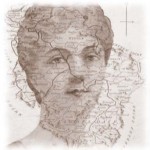 Have no doubt that your family tree research has value beyond the current generations of your own family.
Have no doubt that your family tree research has value beyond the current generations of your own family.
Donating your family history to a local historical or genealogy group is an excellent way to make certain all of your hard work is put to good use. Local Historical Societies and Genealogy groups have a stake in preserving your records for future generations.
How to Donate Your Family Tree
If you are considering donating your family tree research the best place to start is by contacting your local library. Your local library can help you identify the archives that are best geographically suited to receive your family’s story.
Generally, community groups are interested in local reference records. However, they may have ties to other groups with broader interests such as provincial or state archives.
When donating a rather widespread family tree it may be worth considering breaking it into smaller portions focusing on specific locations.
While it is normal in a large family tree to have a significant geographical spread with ancestors coming from all corners of the globe, a local group may have limited space. Therefore, it is reasonable that they may not want to house large documents unless they are completely location specific.
What to Include with Your Donation
Along with your family tree templates or pedigree charts, you should include either originals or copies of:
- Primary and secondary source documents
- Old photos
- Vital Records
- Newspaper clippings
- Maps
Donating your family tree data is one of the best ways of sharing your genealogy and contributing to the preservation of history in your community. Not only does it help preserve your research for future generations it may be key to helping another family history researcher to break down a brick wall.
However, before you donate be sure not to part with any original items you or other members of your family may want to keep. Lastly, make certain that all of your research conforms to The Big Five Genealogy Standards and Guidelines.
To learn more about genealogical standards sign up today for Genealogy Beginner’s 30-day free trial and receive Eight, Step-by-Step Weekly Lessons You Can Do At Your Own Pace. Starting with Lesson 1: Genealogy Standards And Guidelines.
Forces War Records
June 23, 2012 by ramona
Filed under Articles, Genealogy Military Records, Genealogy Records 101, Latest News
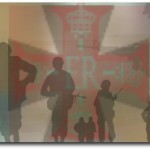 If you are searching for ancestors who served in the British Military Forces, you may want to check out Forces War Records; a new genealogy site that looks to be one of the best-organized search sites of its kind on the net.
If you are searching for ancestors who served in the British Military Forces, you may want to check out Forces War Records; a new genealogy site that looks to be one of the best-organized search sites of its kind on the net.
Forces War Records has over four million records for British Armed Forces personnel.
However, what makes this site special for family tree researchers is its search system. The records are cross-matched with bases, and regiments as well as Ships of the British Armed Forces, providing a usage that is easy to apply, accurate and time saving.
|
The Records Include
|
|
|
World War One World War Two Crimean War Databases Boer War Databases African Wars Databases Indian Mutiny Databases Napoleonic Wars Databases Medal Rolls |
Individual Battle Data Other Wars Casualty Lists Prisoner of War Records Royal Marines Databases Fighter and Bomber Command Losses Fleet Air Arm Data RFC/RAF List RN Losses |
|
Shot at Dawn Database and more !!!
|
|
The site has many cool features including:
- A free search for WWII POWs with information that lists
- Name
- Rank
- Service Number
- Regiment
- POW number
- Camp type/number and location plus notes.
- A free medieval search with search tips
- A community forum
- Tutorials
- A “Memories” section where you can record your own or read stories left by other members.
- Genes Magazine: an online journal that gives access to How to and historical articles.
Some other aspects of the site include the ability to save your searches and bookmark pages to your profile. Of course, registration is required to use the site and there is a reasonable fee for full access to records. Although the fees are reasonable, prospective users should be aware that they are in pounds sterling.
Before you get started on your search at Forces War Records, be sure to download Genealogy Beginners Military Research Tracking Form, available with your 30-day free trial membership.
Politics and Genealogy
June 20, 2012 by ramona
Filed under Articles, Latest News
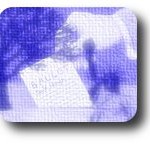 For most people genealogy is an enjoyable pastime, a pursuit of our heritage that helps to answer questions about why we are the way we are and how we got here.
For most people genealogy is an enjoyable pastime, a pursuit of our heritage that helps to answer questions about why we are the way we are and how we got here.
However, when it comes to politics and the genealogies of politicians it seems the stakes of knowing your line of decent are a little higher.
Political Family Trees and the Media
The spin that is put on the importance of a politician’s family tree sometimes defies reason. Certainly, it is understandable that the personal history of political candidates should have some bearing. After all the voting public has a right to know just who they are placing in a position of leadership.
Yet it seems curious that the cultural history or ethnicity of a perspective leader’s ancestors should create such media buzz, much less hold sway with the voting public.
Family History Headlines
From the time 35th President of the United States, John F. Kennedy’s Irish decent came into the
spotlight in 1963; genealogy has played a role in politics. 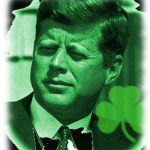

A great example of this type of speculative Genealogy-gone-wild is the media frenzy surrounding President Barak Obama’s family history. During his campaign and following his 2008 election, countless stories of the president’s ancestors made it onto the pages of distinguished publications, such as the New York Times.
More recently, the news has been filled with a different type of genealogy story and controversy is at the heart of it with genealogists coming out of the woodwork to contest the family tree claims of political hopefuls.
The latest political family tree to come under scrutiny is that of senatorial candidate Elizabeth Warren whose claim to Native American ancestry is being challenged by the Cherokee Nation, the United Keetoowah Band of Cherokee Indians, and the Eastern Band of Cherokee Indians along with Cherokee genealogist Twila Barnes.

Barnes know for her genealogy blog “Polly’s Granddaughter” is a notorious “Wannabe Hunter” who strongly discourages any and all from making claims to Cherokee heritage without first producing the documentation to prove it.
It seems that genealogy and politics has clearly developed a love hate relationship and while it is, being determined if “politics is in the blood”; votes may hang in the balance.
Family Tree Webinar News
June 18, 2012 by ramona
Filed under Articles, Latest News
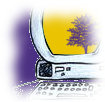 Are you yearning to discover the details about the newest genealogy technology or become skilled at digging up old records?
Are you yearning to discover the details about the newest genealogy technology or become skilled at digging up old records?
June is jam packed with great webinars for family tree enthusiasts. Whether you are a beginning genealogist or seasoned professional, you are going to love this month’s line up of webinars across the net.
June Webinars:
|
Date/ Time |
Subject |
Website/ REGISTER: |
| June 2021:00 – 22:00 | Genealogy Hacks: Tricks to Crack the Top Genealogy Web SitesWith Rick Crume | REGISTER: https://www1.gotomeeting.com/register/586250704 |
| June 2014:00 – 15:30 | Marriages and Anniversaries. Mining newspapers for engagements, marriages, anniversaries, and divorce records.With Thomas J. Kemp | Legacy Family Tree |
| June 2114:00 – 15:30 | Mapping Your Ancestors’ FootstepsWith Kathryn Lake Hogan | https://www3.gotomeeting.com/register/415630494 |
| June 2214:00 – 15:30 | Staying Safe with Social Media.With Thomas MacEntee | Legacy Family Tree |
| June 2521:00 – 22:30 | WordPress Part 2: Dissecting the DashboardWith Taneya Koonce | REGISTER: https://www1.gotomeeting.com/register/547184313 |
| June 2714:00 – 15:30 | Digital Images for Genealogists and Technologists: scanning, digitizing, editing, and preserving your photos.With Geoff Rasmussen | Legacy Family Tree |
Before you sign on remember to:
· Check that you have all of the system requirements
· Register (if needed)
· Download any required software
· Mute your Mic
· Log in Early
After you have been inspired and motivated check back with Genealogy Beginner and make sure, you are stocked up on Family Tree Charts and Research Tracking forms.
Available with your Genealogy Beginner Starter Kit when you register for a 30 Day Free Trial.
Genealogy: Getting to Know Your Ancestors
June 14, 2012 by ramona
Filed under Archives, Family History, Genealogy groups, societies and organizations, Latest News
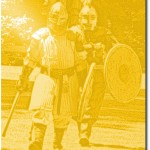 The Merriam Webster Dictionary gives a definition of genealogy as:
The Merriam Webster Dictionary gives a definition of genealogy as:
- an account of the descent of a person, family, or group from an ancestor or from older forms
- the study of family pedigrees
Strictly speaking, this is true; it is certainly a good definition of the process and an accurate descriptor of the intent with which genealogy is first approached. However, to those of us who have spent any length of time on this addictive hobby, the study of our ancestors begins to take on new meaning.
It is not long after family tree research begins that the dry definitions become inadequate. As we work our way through record after record, learning piecemeal the details of our ancestors lives we begin to feel we are getting to know them as individuals.
For some, the genealogical aspects of family history research are not enough. We want to get to know our forefathers on a deeper level. Become more familiar with their day-to-day lives.
If you count yourself among those wishing for a deeper understanding of your generations past, there are a number of activities you can participate in; activities that will allow you to experience your family history in a very real way.
Recreationists
Pick almost any period in history and you will find a group of people actively recreating the era. Living history groups include the activities, dress and tools of the eras they portray to give participants the sense of stepping back through time. Recreationists are not re-enactors; they are not scripted nor are they involved in recreating specific events. Member’s interests can include clothing styles, pastimes, cookery and artisanship, everything that would help create a feeling of every day life in bygone days. It is not at all surprising that among their ranks you find many genealogists and family historians.
Living History Groups
From late 20th century groups like “The 20th Century Revisited” A UK based group recreating scenes and events from various parts of the later 20th Century including WW2 resistance, and 1970 British Army of the Rhine (BAOR) or “Paper Dolls” An international group made up of female members who portray military and civilian life during World War Two. From hometown sweethearts, Women’s Land Army, French Resistance, American Red Cross, Women’s Army Corps. These groups offer an opportunity to learn what it was like for ancestors who lived during the great wars; both on and off the battlefield.
If you are more interested in the events of the 19th century The Living History Society of Minnesota members can attend workshops and participate in activities designed to increase their knowledge of mid 19th century life. For those whose Gr,Gr,Gr, Grandfathers heeded the familiar call of “Go West young Man” the Mojave Muleskinners have several branches across the US, Canada and the UK where you can immerse yourself and learn about life in the old west.
If you can trace your family tree to medieval times, a living history group from the Middle Ages may be more suiting. The Society for Creative Anachronism (SCA) is an international organization with over 30,000 members residing in countries around the world. One of the best things about this group is that you will find a mix of cultures from Viking to Italian to Middle Eastern. Members attend events such as tournaments, royal courts, feasts, dancing, various classes, workshops and more. The SCA is a group that lets you explore all of the European lines in your family tree.
If you want to know more about how living history groups can help enrich your genealogy and family history or how to find a group near you, just post a question to the Genealogy in General board on the Genealogy Beginner forums.
Is Ancestry.com for Sale?
June 6, 2012 by ramona
Filed under Articles, Latest News
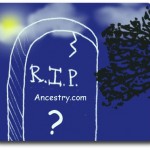 A report June 6, 2012 at Investors.com states genealogy service Ancestry.com is contemplating a sale of the company.
A report June 6, 2012 at Investors.com states genealogy service Ancestry.com is contemplating a sale of the company.
A leader in genealogy services since 1983 Ancestry.com is the biggest online family history service with several websites that aid people in tracing their family trees.
The genealogy giant totals 1.87 million paying subscribers and offers well over seven billion searchable records. On the inside, the company employs 1,100 people and reports June 5, 2012 from the Deseret News state that along with their recent purchase of Archives.com in April 2012 for $100 million, there are also plans to hire 50 to 70 new tech personnel.
The company based in Provo, Utah has seen an overall slow down in subscriber growth and in response is said to have hired Frank Quattrone’s San Francisco based company, Qatalyst Partners to source buyers.
Taken as a whole Ancestry.com finished the first quarter of 2012 with:
Despite this, last month’s cancellation of Who Do You Think You Are, a major promotional vehicle for the company, hit them hard when stocks dropped 13.7% after NBC announced the shows cancellation.
Genealogy Death Records: Cause of Death
May 25, 2012 by ramona
Filed under Articles, Genealogy Death records, Genealogy Records 101, Latest News
 Records of our ancestor’s deaths can reveal vital clues that help with tracing the family tree. Genealogists have long recognized the importance of the information held in these records such as names, dates and places.
Records of our ancestor’s deaths can reveal vital clues that help with tracing the family tree. Genealogists have long recognized the importance of the information held in these records such as names, dates and places.
However quite often, family historians want more than the dry facts. We want to get to know our ancestors through the paper trails they have left behind. Even more importantly, we sometimes want to learn more about a family history of disease.
Causes of Death in Your Family Tree
While obtaining these records has become easier over the years, understanding the cause of death is often a conundrum. Whether they are natural or accidental, causes of death can be extremely perplexing.
Even when they seem straight forward, like in the case of P. Sinclair whose death record stated lost at sea. After a good deal of research went into determining where he was lost at sea it was discovered that the term was often applied to sailors who had celebrated a little too heavily while on leave and drowned from drunkenly falling off the dock.
Making things more difficult are archaic medical terms that seem quite bizarre to our 21st century minds. It is hard to know what is meant when the cause of death cited is poisoned face.
Not all causes of death on old records are as extreme as the example above however they can still be a challenge. Here is a look at some common and not so common terms you are likely to run across in your research.

The causes of death found in ancestral records are as diverse and numerous…well, as our ancestors.
If you are interested in tracking this fascinating subject in order to research and document possible hereditary diseases, Genealogy Beginner recommends using our Major Milestones Tracking Form. Download yours today with your 30 Day FREE Trial.
Family Heirlooms: Preserving the Past
May 20, 2012 by ramona
Filed under Articles, Family History, Latest News, Preserving Your Family Tree
 Those interested in climbing their family tree often have a passion for the stories and keepsakes passed from generation to generation.
Those interested in climbing their family tree often have a passion for the stories and keepsakes passed from generation to generation.
It is not surprising that they frequently find themselves the guardians of traditions, stories and irreplaceable family heirlooms. Family heirlooms come in many forms, from jewelry to old diaries to 100-year-old garments like christening gowns.
Being the keeper of the family treasures is a big responsibility and rarely taken lightly. While some heirlooms are easily cared for, others such as very delicate old textiles like quilts, needlework pieces, dolls and garments require very careful handling.
Old Textile Do’s and Don’ts
Caretakers with the best of intentions sometimes damage old textiles through lack of knowledge. The following list will help family historians in following the first rule of caring for your family’s textile keepsakes…do no harm.
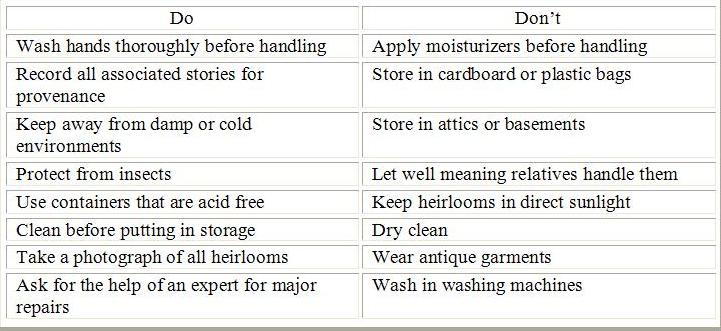
Cleaning Old Textiles
Old textiles are often weakened through time. When cleaning never wring, scrunch or hang them as they may tear easily. Always lay them out flat to dry and wrap them in acid free tissue paper or a clean white cotton sheet before storing. It is very important that heirloom textiles are always stored flat and never crushed.
Wool
Before you clean any antique woolen garment, it is a good idea to test it for color fastness. To do this simply apply a little water then squeeze it in between some paper towel. If the color bleeds, you will need to give it a vinegar treatment to stabilize the dye. To do this, soak the garment in a mixture containing one gallon of water to one tablespoon of white vinegar for five to ten minutes. To dry the garment place it between a couple of thick absorbent bath towels, press out excess moisture and lay flat to dry.
Cotton
Cottons have a tendency to yellow with age and shrink if not dried properly. Before attempting to wash any cotton garment or textile, try cleaning with a soft brush and a low suction vacuum. When cleaning cotton garments it is best to treat stained areas with hydrogen peroxide rather than to attempt cleaning the entire garment. Before attempting, any major restorations consult a professional.
If you’re the guardian of your families textile treasures Genealogy Beginner recommends reading “The Textile Conservator’s Manual”, by Sheila Landi available from Amazon.com.
WDYTYA Cancelled: A Sad Farewell
May 16, 2012 by ramona
Filed under Articles, Latest News
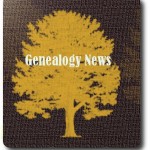 With only four million viewers for this season’s premier and steadily tumbling ratings, NBC has cancelled the genealogy program “Who Do You Think You Are” in its third season…and it is a sad farewell for many fans.
With only four million viewers for this season’s premier and steadily tumbling ratings, NBC has cancelled the genealogy program “Who Do You Think You Are” in its third season…and it is a sad farewell for many fans.
Over its three-year span, the show produced by Lisa Kudrow has helped an A-list of big names such as Gwyneth Paltrow, Susan Sarandon and Martin Sheen to trace their family trees all over the globe. The show should also be credited for the part it has played in inspiring a great many viewers to search out their own ancestral roots.
No one will miss the show more than sponsors Ancestry.com as the backlash hit them hard when stocks dropped 13.7% after NBC announced the cancellation.
In April of last year, Ancestry.com’s stocks were at a peak with a worth of $45.79 and 1.7 million subscribers. At the opening of trading on Monday May 14, 2012, the genealogy giant’s shares were sitting at $26.16. By the close of the day, stocks had devalued to $22.57 losing $3.59 through the day.
In a press release earlier this week Tim Sullivan, President and CEO of Ancestry.com said, “We want to thank NBC for their support of this terrific series, which over the last three years has inspired many viewers to follow their passion to learn more about who they are and where they come from,” adding, “We have a great partnership with the show’s producers, Is or Isn’t Entertainment and Shed Media, and we look forward to exploring other avenues of distribution.”
The programs last episode will air tonight with celebrity guest Paula Deen.
Family Heirlooms: 19th Century Photographs
May 13, 2012 by ramona
Filed under Articles, Family History, Latest News, Preserving Your Family Tree
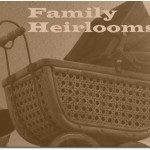 Often making a journey across time and continents, family heirlooms are a solid physical connection to a very personal ancestral past that tend to hold memories, which resonate deep within us.
Often making a journey across time and continents, family heirlooms are a solid physical connection to a very personal ancestral past that tend to hold memories, which resonate deep within us.
Those who have held their great-grandmothers wedding dress or read the letters written home from a relative who served in a war understands the deep link felt across the generations. One truth shared by all family treasures is that… it is the stories that accompany them that give them the greatest meaning and tie us to our generations past.
Sadly, sometimes the objects remain while the stories are lost. Genealogically this can be a great opportunity to discover a new family history story or ancestor. If you have, an heirloom that has become a bit of a mystery an investigation may be in order. The type of investigation you conduct will likely depend on the object you are investigating. While family heirlooms are made up of every object imaginable, from jewelry to family bibles. Often the photographs pose the most problems…particularly very early ones.
19th Century Photographs
The first step in solving the puzzle of a mysterious early period photograph is deciding what type of photo you have. A difficult task with these three photo types of the 19th century.
Daguerreotype:
A good way to decide if it is a Daguerreotype is to hold a piece of paper over the surface and see if the image is reflected in reverse. Additionally, Daguerreotypes are often tarnished around the edges of the picture. If it is a Daguerreotype is will date from 1839-1860.
Ambrotype:
Ambrotypes are often hand tinted. To figure out if what you have is an Ambrotype carefully remove it from the case and hold it up to the light. Ambrotypes were printed on glass so you should be able to see through it. Another clue is to look for any cracks or peeling as another hallmark of the Ambrotype is the black paint used to process the picture. Ambrotypes date from 1854-1865.
Tintype:
It can be hard to tell the difference between a Tintype and an Ambrotype. The only way to be certain is to hold a magnet near it. Tintypes were made of a very thin iron and should be attracted to the magnet. Tintypes were common during the civil war and date from 1856-1920.After you have determined the type of photograph, you may need to track down its geography. A hint you may find helpful, is through the clothing worn by the people in your photograph. Clothing, accessories and hairstyles may be great hints for women, while uniforms can be a dead give away for men. All can help you to zero in on the country or origin. Once that is determined, the next step is to search for period photographers from that country. Several indexes by country list photographers so you should not have too much trouble once you know the photo type.
Additionally, some early photographers may have developed an identifiable style that can be helpful in tracking them down. For example, there may be preferences in the manner which subjects are posed (seated or standing), or backgrounds and props used may offer some clues. This process can be very time consuming, as it is a matter of searching and comparing your photo to the ones found in your search. Even at that, be cautious about your conclusions.
Solving the mystery of your family heirloom can be fun and rewarding. Better yet, it may help flesh out your family history, add new branches to your family tree and fill out another space on your family template. All good reasons to start your detective work A.S.A.P.
If you have a mystery, post it in the Ask A Genealogist forum, or share with us how you solved a mystery on the Discovery Panel and tell us how you did it. Genealogy Beginner would love to hear about your family treasures and heirloom stories.
